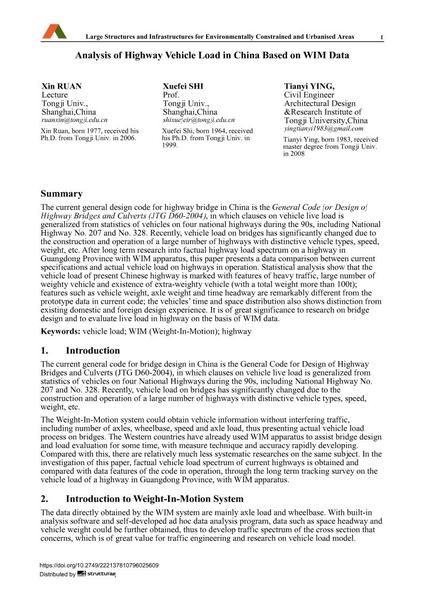Analysis of Highway Vehicle Load in China Based on WIM Data

|
|
|||||||||||
Bibliografische Angaben
| Autor(en): |
Xin Ruan
Xue-fei Shi Tianyi Ying |
||||
|---|---|---|---|---|---|
| Medium: | Tagungsbeitrag | ||||
| Sprache(n): | Englisch | ||||
| Tagung: | IABSE Symposium: Large Structures and Infrastructures for Environmentally Constrained and Urbanised Areas, Venice, Italy, 22-24 September 2010 | ||||
| Veröffentlicht in: | IABSE Symposium Venice 2010 | ||||
|
|||||
| Seite(n): | 512-513 | ||||
| Anzahl der Seiten (im PDF): | 8 | ||||
| Jahr: | 2010 | ||||
| DOI: | 10.2749/222137810796025609 | ||||
| Abstrakt: |
The current general design code for highway bridge in China is theGeneral Code for Design of Highway Bridges and Culverts (JTG D60-2004), in which clauses on vehicle live load is generalized from statistics of vehicles on four national highways during the 90s, including National Highway No. 207 and No. 328. Recently, vehicle load on bridges has significantly changed due to the construction and operation of a large number of highways with distinctive vehicle types, speed, weight, etc. After long term research into factual highway load spectrum on a highway in Guangdong Province with WIM apparatus, this paper presents a data comparison between current specifications and actual vehicle load on highways in operation. Statistical analysis show that the vehicle load of present Chinese highway is marked with features of heavy traffic, large number of weighty vehicle and existence of extra-weighty vehicle (with a total weight more than 100t); features such as vehicle weight, axle weight and time headway are remarkably different from the prototype data in current code; the vehicles’ time and space distribution also shows distinction from existing domestic and foreign design experience. It is of great significance to research on bridge design and to evaluate live load in highway on the basis of WIM data. |
||||
| Stichwörter: |
Autobahn
|
||||
